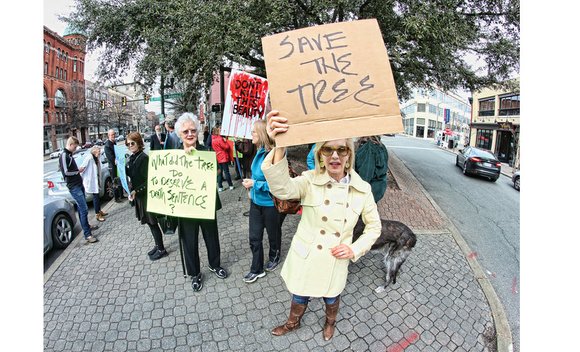Walker statue to rise above Downtown plaza
Jeremy M. Lazarus | 2/26/2016, 5:02 a.m.
The bronze statue of Richmond businesswoman Maggie L. Walker is to be the centerpiece of a 3,000-square-foot circular plaza made of granite.
The preliminary design was unveiled last Saturday to an audience of about 100 people at the Richmond Public Library’s Main Branch in Downtown.
According to sculptor Antonio T. “Toby” Mendez, the statue would stand 10 to 12 feet tall and rise even higher on a 4- to 6-foot base in the center of the planned plaza at Adams and Broad streets in Downtown.
As the Free Press reported last week, the live oak tree that now dominates the approved site, called the gateway into Jackson Ward, is eliminated in the proposed design.
Mr. Mendez said the tree had to go if the figure of Mrs. Walker is to have pride of place.
“If the tree stayed, it would take up so much room that the statue would have to be moved to the sidewalk,” he said.
The design includes 12 black granite benches inside the plaza for people to spend time with the statue. While the plaza itself would be crafted mostly of gray or white granite, black granite bands inscribed with quotes from Mrs. Walker or historical references would be inset into the space.
The design also calls for landscaping to include perennial grasses that change color in different seasons and smaller, background trees.
This is an expensive project. Mr. Mendez has been awarded a $300,000 contract to create the statue and base, and a preliminary estimate suggests the city would need to spend $400,000 to $500,000 to develop the proposed plaza.
Because Mr. Mendez offered no alternate design, the tree’s removal is essentially a done deal, even if the Richmond Planning Commission officially has final approval on the project. With city officials expecting the commission to act by mid-April to approve the design, there would be little, if any, time to come up with an alternative.
With the design in hand, Mark Olinger, city director of planning and development review, made it clear that the push is on to complete the internal reviews quickly so the project can go to bid and be started within a few months.
Mr. Olinger said the goal is to have the city Planning Commission vote on the final design at its meeting Monday, April 18. He said that would give the city Public Art Commission and the Urban Design Committee time to offer their recommendations.
Any delay would mean that the statue and plaza likely could not be completed in time for Mayor Jones to unveil the finished product before he leaves office Dec. 31.
Even if the schedule is met, Mr. Mendez said he could not guarantee that the statue would be finished by December. He said that he expects to finish the clay model by August. Then, it would take another four to six months for the Baltimore foundry he uses to cast the bronze figure from the model, he said.
He said that he wants to ensure the casting is done right.
“I’m not going to rush the process,” he said. “It will take as along as it takes.”
Based on the public comments received Saturday, the removal of the live oak tree appeared to cause little angst among the audience members who came to get the first look at the proposed statue and plaza design, including Mayor Dwight C. Jones, who once supported keeping the tree.
Mayor Jones said he found the treeless design Mr. Mendez and the plaza design team from VHB Boston showed off in a series of renderings very acceptable.
That was also the case with Gary Flowers, who led a petition drive seeking the tree’s removal. He said he was impressed with much of what he saw, which he said provides appropriate recognition to a Richmond hero.
“People who come will look up to her,” he approvingly told the sculptor.
Some concerns were expressed about elements of the design.
Viola O. Baskerville, a former Richmond City Council member and former state secretary of administration, expressed disappointment that Mrs. Walker’s statue would be placed on a pedestal and be out of reach of children.
“She ought to be more accessible,” Ms. Baskerville said, similar to the Civil Rights Monument at the State Capitol.
She recalled seeing a youngster place a scarf around the figure of a child on the Capitol Square monument, which sits at ground level. “That’s the kind of interaction we should be promoting,” she said.
However, Mr. Mendez disagreed, saying the raised base is more appropriate for Mrs. Walker’s statue.
Mr. Flowers was among those who expressed concern about the 13 proposed background trees to be planted among the bricks surrounding the plaza and along Adams Street. He and others said they envision the trees attracting birds with their droppings possibly marring the statue. They said they are skeptical about the city’s ability to keep the site attractive.
Jean Garbier, a landscape designer from VHB, said the background trees would have trunks that grow like columns. She said they were included in the design to screen out some of the busy background of buildings.






